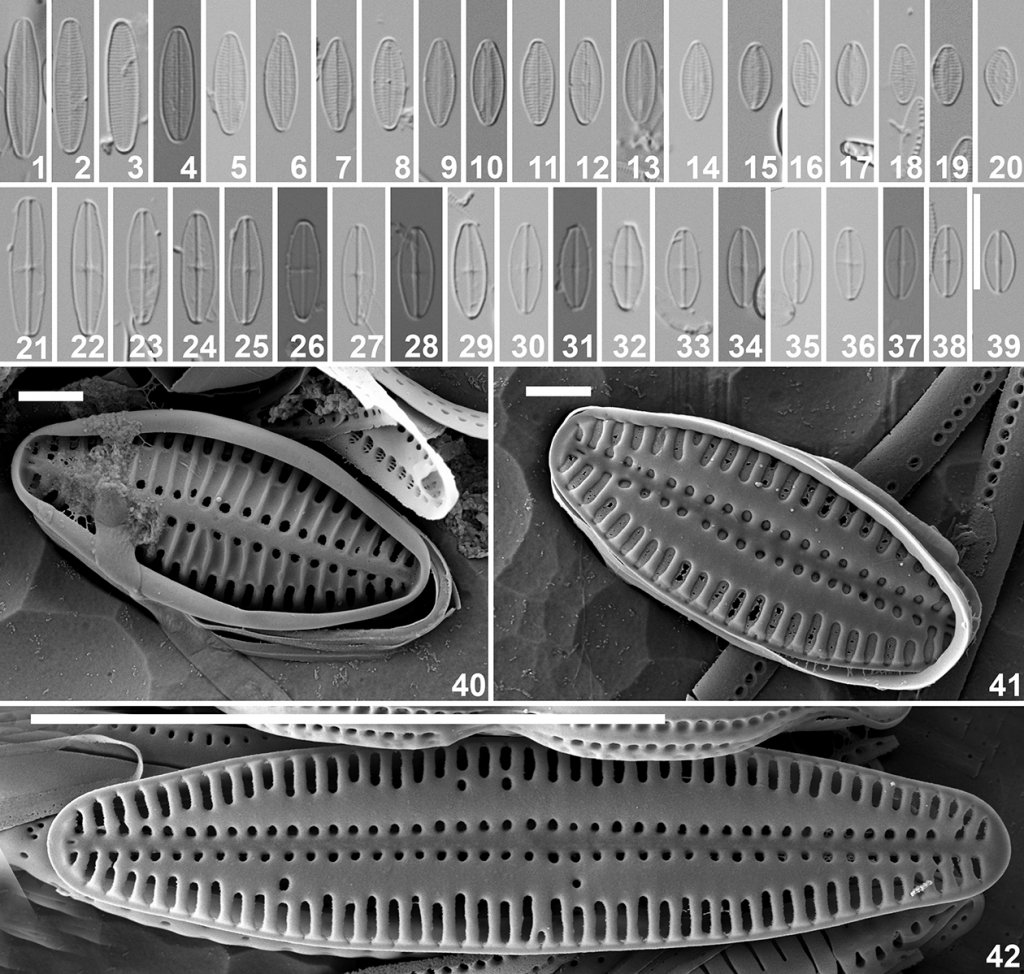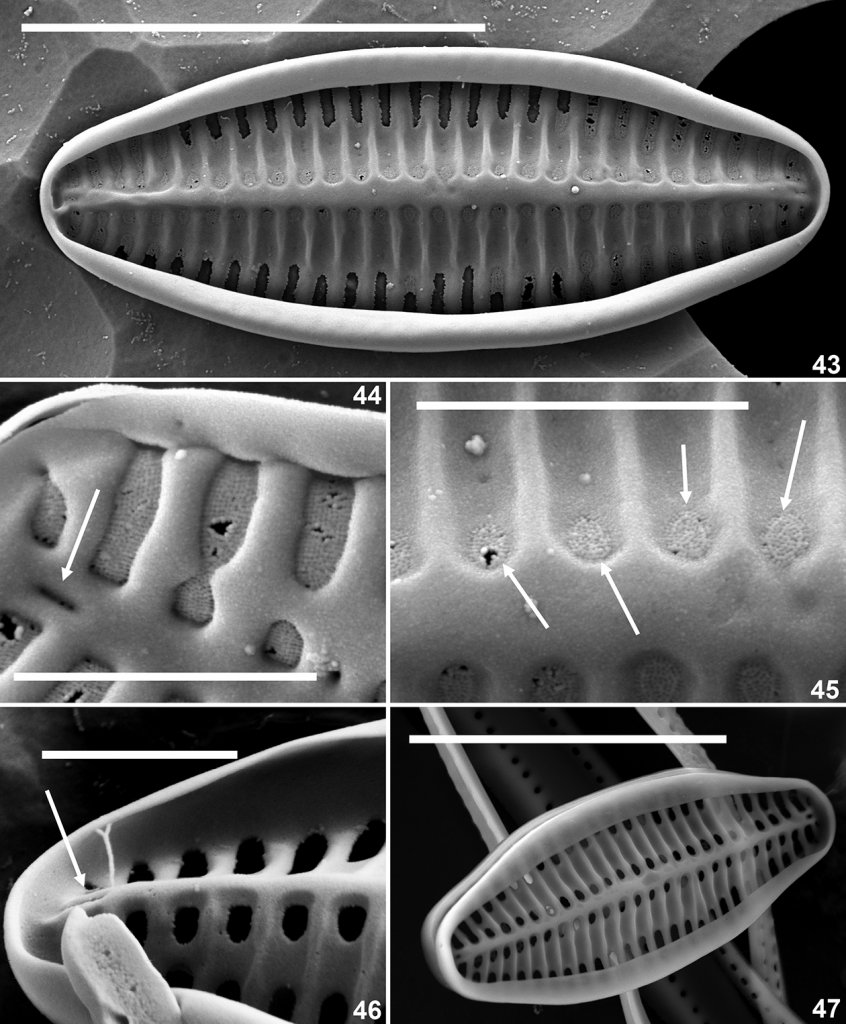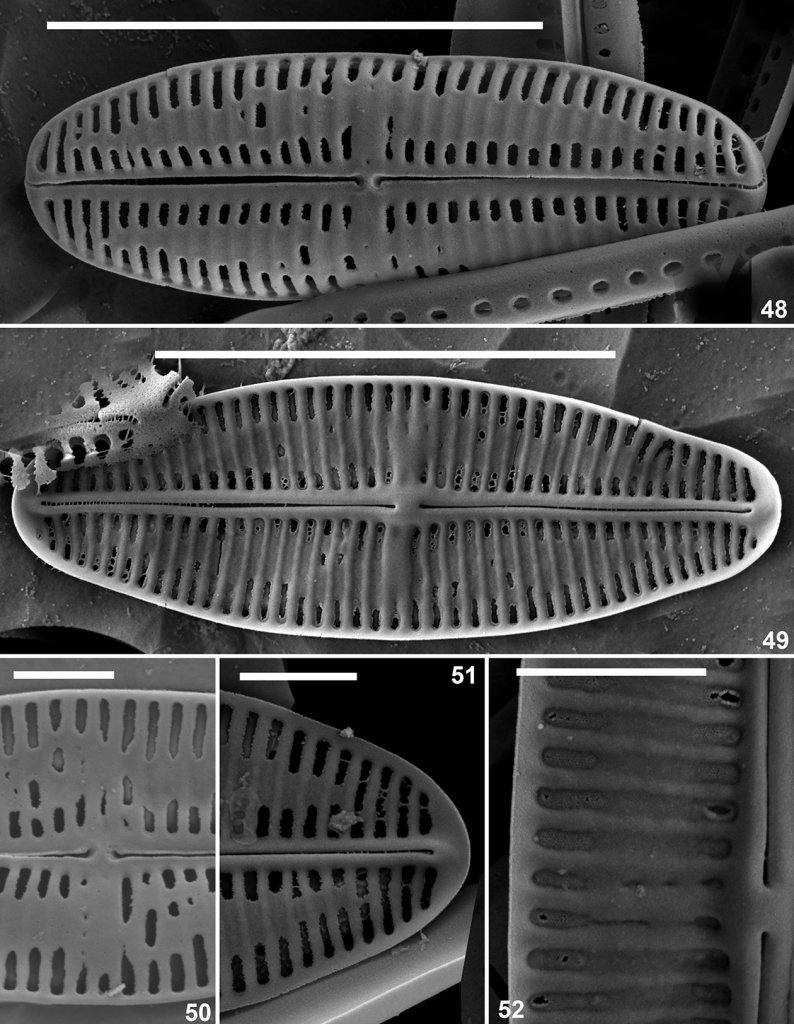Isotype of this species is deposited in the Croatian National Diatom Collection as permanent slide under accession number HRNDC000437.
The new genus is named after our dear friend and colleague, Dr Roksana Majewska (Southwest University, Potchefstroom, South Africa) in honor of her impressive scientific contributions to the study of diatom taxa associated with sea turtles.
Heterovalvate, monoraphid frustules composed of a raphe–bearing valve and a rapheless valve. Frustules relatively small. Raphe valve (RV): valve face relatively flat, rarely curved. Mantle very shallow. Raphe branches straight. Central raphe endings closely positioned to each other, shortly hooked, weakly expanded. Terminal raphe fissures bent, continuing onto the valve mantle. Striae composed of one macroareola, only near the valve apices continuous from axial area to valve margin. Most of the striae interrupted by large hyaline plate dividing the macroareolae in two parts. Areolae covered externally by porous hymenes. Virgae internally thickened, clearly raised. Raphe sternum clearly raised with developed central nodule. Central raphe endings straight to weakly deflected into opposite directions. Terminal raphe endings terminating onto small helictoglossae. Sternum valve (SV): Valves weakly convex with clearly developed, thickened, linear sternum. Mantle shallow. Striae composed of macroareolae, clearly interrupted by a large hyaline plate forming one rounded areola near the axial area and one transapically elongated areola at valve margin, both covered by porous external hymenes. Distinct, raised ridge surrounding the valve face, folded inwards over the valve margin. Internally, hyaline plate dividing the macroareolae obvious. Small vestige–like raphe slits present. Raphe sternum sunken. Girdle composed of at least two open, narrow, unperforated bands.
The specific epithet ‘istriaca’ refers to the Istrian peninsula where the loggerhead turtle was found.
Majewskaea istriaca was so far only found on the carapace of a loggerhead turtle. The associated diatom flora was very diverse and species–rich and composed of Catenula exigua Robert et al., an unknown Bifibulatia Takano species and several Nitzschia Hassall, Fallacia A.J.Stickle et D.G.Mann, Parlibellus E.J.Cox and Amphora Ehrenberg ex Kützing species.



Light Microscopy (Figs 1–39): Frustules heterovalvate. Valves linear, linear–lanceolate to lanceolate with straight to convex margins and weakly protracted, rostrate, broadly rounded apices. Smaller valves becoming almost elliptical. Valve dimensions (n=50): length 6–15 μm, width 3–4 μm. SV: Sternum raised above valve plain, often discernible in LM (Figs 8, 10, 12, 16). Striae parallel throughout almost the entire valve, becoming slight radiate towards the apices, 30–32 in 10 μm. RV: raphe sternum clearly developed, linear running distinctly from apex to apex. Raphe branches not or very weakly (Figs 22, 25, 29: discernible in LM. Axial area very narrow. Central area often rather distinctly but irregularly thickened. Striae nor areolae visible in LM.
Scanning Electron Microscopy (Figs 40–51): Girdle not well studied due to lack of observations, even of untreated material. Girdle bands open, narrow, thin, unperforated (Figs 40, 41). Fig. 44 showing open nature of girdle bands. SV (Figs 40–47): Mantle very shallow. Internally sternum depressed, linear (Figs 41, 42). Very short, vestige–like raphe slits visible near apices (Figs 41, 42, 44, arrow). Striae interrupted by continuous hyaline plate subdividing the areolae usually in two parts (Figs 41, 42). Axial sternum bordered by continuous series of large rounded, areolae, part of larger macroareolae (Fig. 42). Near valve edge transapically elongated parts of macroareolae present. Occasionally, third areola visible near valve margin (Fig. 42). Externally, well–developed ridge surrounding the entire valve, larger near valve center. Ridge clearly folded inwards, partly covering the marginal areolae of the striae (Figs 43, 46, 47). Sternum thick, raised, linear to lanceolate (Figs 40, 43). Virgae raised extending from the sternum towards the valve margins (Figs 40, 43, 47). Striae depressed between virgae (Figs 43, 45). Areolae clearly covered by perforated hymenes (Fig. 45, arrows). Vestigial raphe slits often visible at apices (Fig. 46, arrow). RV (Figs 48–52): Raphe branches straight with shortly, unilaterally hooked central endings bearing only weakly expanded pores (Figs 48, 50). Terminal raphe fissures bent, continuing onto the mantle (Fig. 48). Striae composed of macroareolae, subdivided by large hyaline plate, ca. 50 in 10 μm. Axial area bordered by series of transapically elongated, short areolae whereas larger part of macroareolae visible near valve margin (Fig. 48). At apices, macroareolae never subdivided, composed of one continuous stria (Fig. 48). Internally, raphe sternum well developed, clearly raised. Central nodule thickened, expanding irregularly towards the valve margins, however, never reaching the margins (Fig. 49). Virgae distinctly thickened with striae sunken between them. Raphe branches terminating onto small helictoglossae at the apices (Figs 49, 51). Centrally, raphe endings occasionally deflected in opposite directions (Fig. 49), usually straight (Fig. 52). Areola coverings visible as perforated, external hymenes (Fig. 52).
Publication